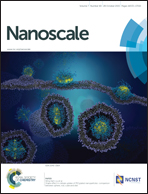Facile synthesis of hydrangea flower-like hierarchical gold nanostructures with tunable surface topographies for single-particle surface-enhanced Raman scattering†
Abstract
The physicochemical properties of noble metal nanocrystals depend strongly on their size and shape, and it is becoming clear that the design and facile synthesis of particular nanostructures with tailored shape and size is especially important. Herein a novel class of hydrangea flower-like hierarchical gold nanostructures with tunable surface topographies and optical properties are prepared for the first time by a facile, one-pot, seedless synthesis using ascorbic acid (AA) to reduce hydrogen tetrachloroaurate (HAuCl4) in the presence of (1-hexadecyl)trimethylammonium chloride (CTAC). The morphologies of the synthesized gold nanoflowers are controlled and fine-tuned by varying the synthetic conditions such as the concentration of reagents and the growth temperature. Due to their unique hierarchical three-dimensional (3D) structures with rich hot spots, these gold nanoflowers exhibit an efficient performance in single-particle surface-enhanced Raman scattering (SERS). The work stands out as an interesting approach for anisotropic particle synthesis and morphological control, and the proposed novel, hierarchical gold nanoflowers have a number of exciting potential applications in SERS-based sensors.


 Please wait while we load your content...
Please wait while we load your content...